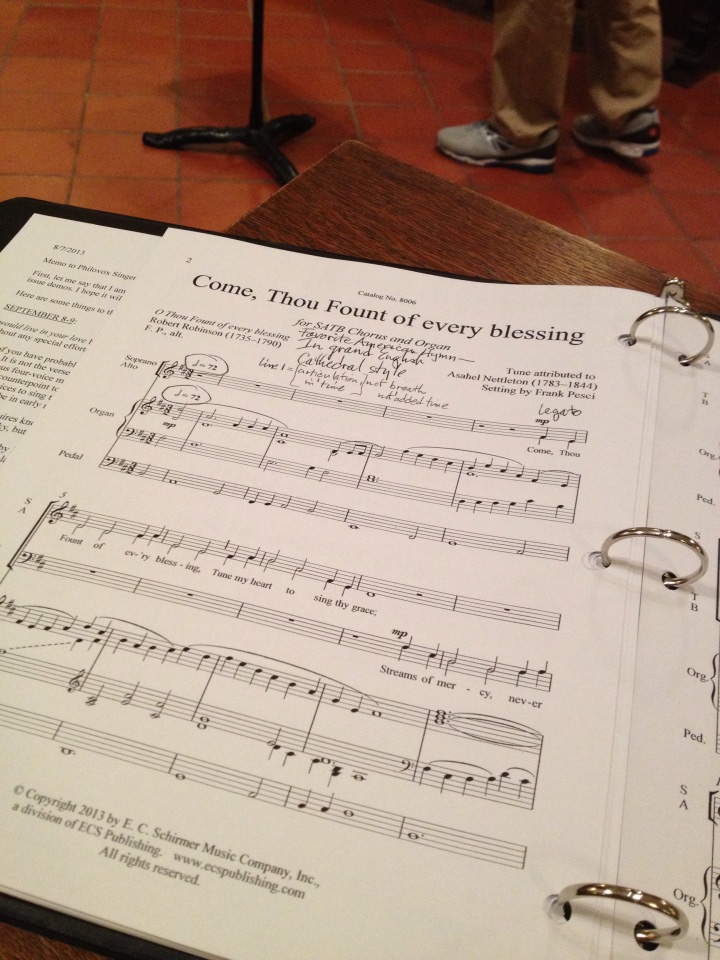I can’t tell you how many times I’ve heard that “music is math.” Whether in relation to something simple (counting), or something more esoteric (highly-developed, academic analyses of harmony and structure), or whether it is a misguided argument to try to convince school boards that studying music will help kids excel at math and science; the phrase keeps coming up. The music/math relationship is most evident for me in terms of the simple relationships between frequencies, particularly frequencies of pitches whose intervals are generally referred to as “perfect.”
Music is sound and sound is movement (specifically, vibration). Frank Zappa said, “Music is the result of shoving around unsuspecting air molecules, usually requiring the assistance of unsuspecting musicians.” The frequency (cycles per second) of this shoving around is detected by the ear as pitch. Pitch, therefore, can be described by a frequency of vibration, which can be represented numerically. As a result, two instruments, or two voices, whose sound making properties are vibrating at the same frequency are producing the same pitch, even if the qualities, or timbre, of the sound that is produced, differ greatly.
Since there are infinite degrees of variation in frequency, parameters had to be set, so that we could talk about the same pitch. Over the years, frequencies have been arbitrarily singled out and defined, using a varying degree of names and reference points, which does not necessarily mean that everyone agreed. Sidebar: For many years, I have searched for an answer to the question of how ‘C’ became the tonal center of keys with no sharps or flats (and, not incidentally, the ‘Do’ of a fixed Do system). The answer probably lies somewhere in the Latin translations of the Greek musical treatises, particularly those of Hucbald and Boethius, in the 8th and 9th centuries. If anybody else heard something different, please let me know.
In modern times, a generally accepted reference point is A 440, meaning, that a 440 Hz frequency (440 vibration cycles per second) is generally recognized as the “A” above “middle C.” However, depending on what part of the world you are in, this is not a universally accepted constant. Even some American orchestras adjust their “A.” The bottom line, for me, is that there is no such thing as “absolute pitch,” just agreed upon reference points (if we can actually get to the point where we do agree).
What is constant is that no matter what frequency an instrumentalist or singer is playing, if another instrumentalist or singer starts producing a tone with exactly the same frequency, the two will be in “perfect unison.” Let’s try it!
First, you will need a “drone” reference pitch. You can use a piano, guitar – anything handy. What would be better would be an instrument that can sustain a pitch without any decay, like an organ, or electronic keyboard. If you don’t have an instrument nearby, you can find drones at www.hearingandsinging.com. This is personal practice – save the joyous and wonderful experience of matching pitch with another singer until after you are able to master each exercise with a drone.
Next, focus on your breathing. Pick a seated or standing position where your upper body is tall, but without tension – especially in your shoulders, neck, and face. Take a few breaths to warm the mechanism. As you inhale, let your ribcage expand naturally. As you exhale, keep your ribcage expanded and your posture tall – don’t let it all deflate.
Now, pick a pitch that fits comfortably in your singing range. As it plays, close your eyes and focus on the sound of the pitch with your ears. Don’t forget to breathe.
When the time is right, relax the jaw to open your mouth, and match the pitch using the I-found-my-keys ‘Ah’. Try it a few times without judging your tone, your volume, how long you can make the pitch last, or the accuracy of your pitch. Make a noise until your air nearly runs out, pause, fill the tank again, and repeat, using your ears to correct your pitch accuracy as you go. Keep your eyes closed.
You may find it difficult to zero in on the perfect unison – there’s a lot working against you: emotions, physicality, technique, fear and frustration, wandering thoughts, the movement of the Earth. When a perfect unison happens, however, even for an instant, note how it sounds and how it feels in your body and your ears. A perfect unison, perfectly sounded, may seem louder and richer than you expect.
Strive for that, then change the pitch of your drone and begin again.



